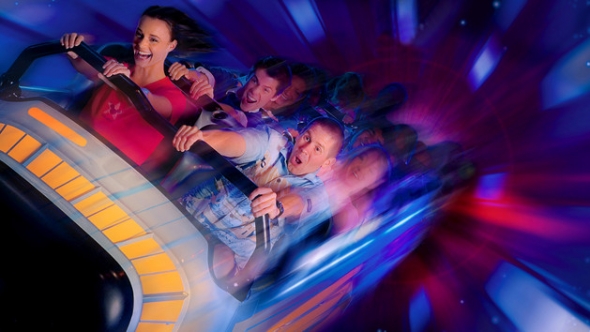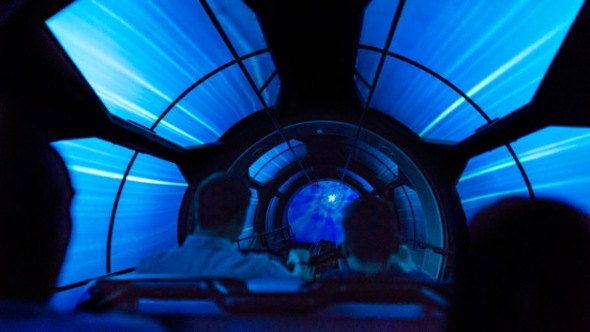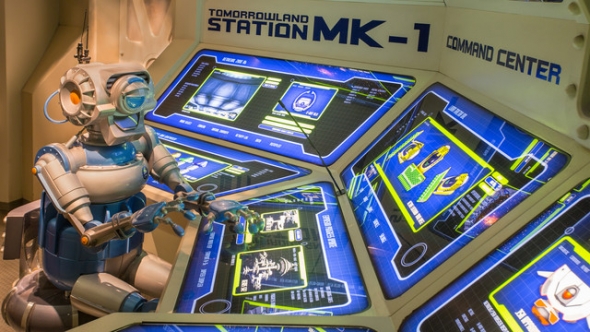Exploring the final frontier
Image: Disney
Hench and his team truly swung for the fences with their Space Port plans, although they’d quickly taken to calling their new attraction Space Voyage instead. Their vision for space travel included plenty of twists and turns that would push the ride into the great unknown at breakneck speeds. Disney had some requirements for their blueprints, though.
Uncle Walt felt strongly that the best way to foster the sensation of space travel was via a dark ride. He preferred to place his coaster indoors in order to control the setting. Disneyland had excelled in repurposing the parlor tricks of filmmaking into enhanced attractions. The staging of a set proved remarkably similar to that of a theme park ride. Disney innately understood that if Space Mountain took place outdoors, the time of day and the weather could fundamentally alter the quality of the experience. He wasn’t about to risk his beloved space exploration simulation in such uncertain conditions.
Receiving the edict that Space Voyage must have an indoor setting, Hench and the other three Imagineers asked for an explanation as to why. They couldn’t accurately recreate the vision of their boss if they didn’t fully understand it. Disney explained to them that he wanted to project attraction elements on the walls in order to persuade park guests that they had truly left Earth behind for an outer space adventure.
That’s where the movie tricks Disney and his artists had learned over the years would come into play. He also appreciated that as scientists learned more about the internal mechanics of space travel, he could alter the wall projections to update Space Voyage. It was another way he was trying to employ the knowledge he’d gained from running Disneyland for the body of a decade. He could now anticipate the problems that cropped up during the maintenance phase. The facts that the attraction would be weatherproof and not impacted by the time of day were happy bonuses.
The other sublime aspect of an indoor ride was that the Imagineers would control the lighting. That meant they would determine what their park guests could see as well as when. The plans for Space Voyage would give them complete control of all phases of the ride experience. Their blueprints reflected this rare power for a ride designer. Everything about Space Voyage was going swimmingly.
But then…
Image: Disney
Moore’s Law dictates that the number of transistors in a circuit doubles every two years. Trust me, there’s relevance here. Intel co-founder Gordon E. Moore deduced this behavior in 1965, roughly around the time when Disney employees were optimizing the plans for Space Voyage. Moore’s initial assumption was that the doubling would occur every year, but he pushed the expectation back to two years in 1975, a point when he correctly anticipated that the rate of growth would slow but largely continue unabated for decades. Mr. Moore is a true genius with a net worth of $7 billion. That didn’t happen by accident.
What his sage evaluation of technological growth forecasted was that if someone lacked the processing power to do something at a given moment, they’d eventually get there. That’s because the technology would continue to improve at a measurably progressive rate. During the mid-1960s, this news proved extremely important to Disney employees.
By 1966, everyone was referring to their new ride project as Space Mountain. The specs they wanted to build for this man-made mountain with a dark ride inside were so ambitious that they needed massive computational powers. That was the only way they could accurately project the hairpin turns required for their space travel simulation.
What everyone involved quickly realized was the computers of the mid-1960s didn’t have Intel inside. Moore wouldn’t found the world leader in computer chips until 1968. Imagineers vented their frustrations about a pothole nobody could have anticipated. Mankind could put a man on the Moon more quickly than it could build a processor fast enough to calculate the trajectory of the specs for Space Mountain. Let’s all take a moment to appreciate just how big Disney Imagineers thought when they built the attractions that have stood the test of time until today.
Everyone grimly accepted that Space Mountain would miss its intended launch window of 1967. What nobody at Disneyland could have realized at the time was that they’d miss it by a decade. That’s because something tragic happened in 1966. Walt Disney died, leaving his company in turmoil as everyone weighed in on the best ways to protect and enhance his legacy. His beloved Space Port would have to take a backseat to other projects, primarily the one in Florida.
Everything old is new again
Image: Disney
Project X eventually succeeded beyond anyone’s wild dreams. It wasn’t without challenges, though. The most frustrating one to park planners was that their wishes for Walt Disney World directly clashed with the desires of the theme park tourists keeping them in business. Walt Disney reviled the idea of his Florida Project becoming little more than a glorified version of Disneyland East. Walt Disney’s Imagineers revered their company founder and passionately attempted to honor his vision for the swampland he’d acquired in anticipation of building a utopian society.
The customers at Walt Disney World had different ideas. Travel during the early 1970s wasn’t what it is today. Airplane flights were primarily for the wealthy, which meant that residents of the East Coast couldn’t visit Disneyland unless they drove for days. They did get Disney television programing, though. They knew about all the attractions at the Happiest Place on Earth that had created such a buzz over the years. Disneyland was open for 16 years before Walt Disney World debuted. That was an eternity for potential theme park tourists to dream about riding the most popular attractions there. That’s why park planners in Orlando, Florida, eventually gave in and built a redux of Pirates of the Caribbean.
When the carriers of Uncle Walt’s legacy mimicked the original park, they rarely enjoyed it. Everyone understood that they were blatantly going against their founder’s wishes, even as he’d acknowledged that the Environmental Prototype Community of Tomorrow should include a Disneyland-esque amusement park. He simply wanted it to stand on its own rather than ape everything accomplished in Anaheim, California.
Money was tight during the early days of Walt Disney World, which is a recurring theme any time The Walt Disney Company has opened a new park over the years. Park planners had to pay close attention to the wishes of their customers. Otherwise, they’d suffer financial shortfalls that would imperil the entire enterprise. Something that surprised the bean counters at Walt Disney World was that this park enjoyed a high volume of traffic from teenagers, which wasn’t true of Disneyland.
What Disney strategists correctly identified was that teenagers wanted thrill rides, and the new Florida park was sorely lacking in those. Some internal discussion led to an evaluation about whether the Matterhorn Bobsleds would convert well at Magic Kingdom. Those ideas quickly fell by the wayside as impractical. Also, such an attraction would stand as yet another retread of Disneyland. Walt Disney World needed something fresh. And that’s why the first Disneyland indoor roller coaster of 1967 wound up as the first Walt Disney World indoor roller coaster of 1975.




Add new comment